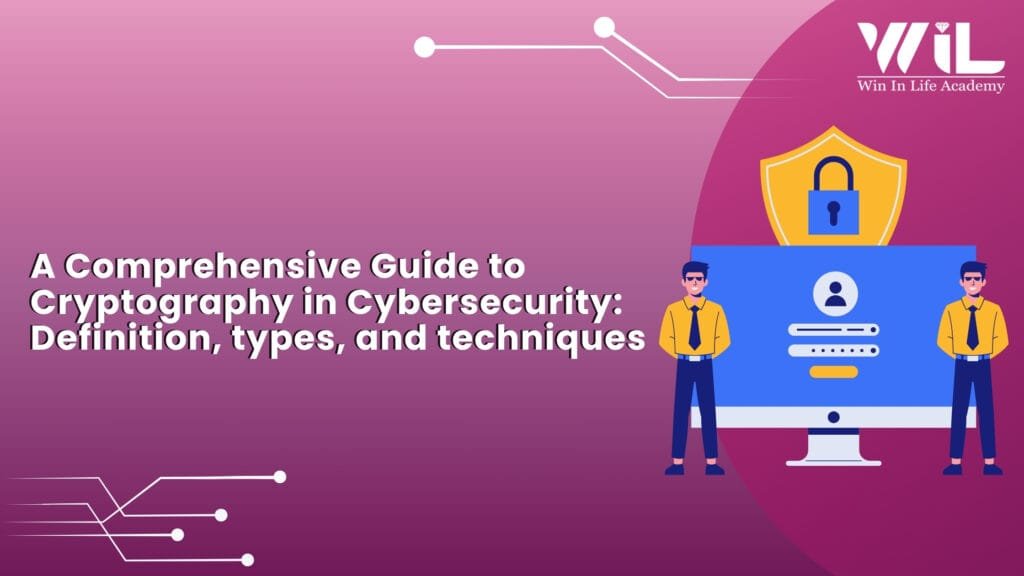Table of Contents
In the ever-evolving landscape of digital threats, safeguarding sensitive information is paramount. Cryptography in cybersecurity stands as the cornerstone of data protection, ensuring confidentiality, integrity, and authenticity. This guide delves into the depths of cryptography, exploring its definition, diverse types, and vital techniques, while touching upon advanced advancements like quantum and post-quantum cryptography.
Enroll now: Cybersecurity Course
Cryptography in Cybersecurity: A Secure Communication
At its core, cryptography is the practice and study of techniques for secure communication in the presence of adversaries. It involves transforming plaintext (readable data) into ciphertext (unreadable data) through encryption and converting it back to plaintext through decryption. The goal is to ensure that only authorized parties can access and understand the information.
The Pillars of Cryptographic Security
Cryptography in cybersecurity relies on four fundamental principles. First, confidentiality ensures that only authorized individuals can access the information. Second, integrity guarantees that the data remains unaltered during transmission or storage. Third, authentication verifies the identity of the sender or receiver. Lastly, accountability prevents the sender from denying that they sent the message.
Worldwide, the cybersecurity market is projected to reach an impressive US$202.98 billion in 2025.
Types of Cryptography

Cryptography employs various techniques, broadly categorized into distinct types.
- Symmetric-key cryptography
- Asymmetric-key cryptography
- Hash Functions
Symmetric-key cryptography uses a single, shared secret key for both encryption and decryption. This makes it fast and efficient, suitable for encrypting large volumes of data. Examples include AES, DES, and 3DES. The primary challenge lies in securely distributing the shared key.
Asymmetric-key cryptography, or public-key cryptography, utilizes a pair of keys: a public key for encryption and a private key for decryption. The public key can be freely distributed, while the private key must be kept secret. This eliminates the key distribution problem of symmetric-key cryptography. Examples include RSA, ECC, and Diffie-Hellman key exchange. Though generally slower than symmetric-key cryptography, it offers enhanced security for key exchange and digital signatures.
Hash functions are one-way functions that generate a fixed-size hash value (digest) from any input data. These are used to ensure data integrity, as any modification to the input data will result in a different hash value. Examples include SHA-256, SHA-3, and MD5, although MD5 is no longer considered cryptographically strong and should be avoided.
Cryptography Algorithms: The Engines of Encryption
Cryptography algorithms are the mathematical functions that underlie encryption and decryption processes. They are meticulously designed to be computationally complex, making it extremely difficult for unauthorized parties to break the code.
AES, or Advanced Encryption Standard, is a widely adopted symmetric-key algorithm that provides strong encryption and is used in various applications, including Wi-Fi security and file encryption.
RSA, or Rivest-Shamir-Adleman, is a popular asymmetric-key algorithm used for secure communication, digital signatures, and key exchange.
ECC, or Elliptic Curve Cryptography, is another asymmetric-key algorithm that offers comparable security to RSA with smaller key sizes, making it suitable for resource-constrained devices.
Diffie-Hellman is a key exchange protocol that allows two parties to establish a shared secret key over an insecure channel. SHA-256, or Secure Hash Algorithm 256, is a cryptographic hash function that produces a 256-bit hash value, commonly used for digital signatures and password hashing.
Applications of Cryptography: Securing the Digital Realm

The applications of cryptography are vast and fill every aspect of modern digital life. Secure communication is achieved by encrypting emails, instant messages, and voice calls to protect sensitive information from eavesdropping. Data storage security is enhanced by encrypting files and databases to prevent unauthorized access and protect against data breaches. E-commerce security relies on cryptography to secure online transactions through SSL/TLS protocols, ensuring the confidentiality and integrity of payment information.
Digital signatures verify the authenticity and integrity of digital documents, ensuring accountability. Virtual Private Networks (VPNs) create secure tunnels for internet traffic, protecting user privacy and data security. Password security is improved by hashing passwords to prevent them from being stored in plaintext, safeguarding user accounts. Blockchain technology uses cryptographic hash functions and digital signatures to secure transactions and ensure the integrity of the blockchain. Cryptocurrencies rely on cryptographic algorithms to secure transactions and manage the creation of new units.
Read our recent blog post on 5 Essential Network Security Strategies to Defend Against Modern Cyberattacks
The Quantum Threat and the Rise of Post-Quantum Cryptography
The emergence of quantum computers poses a significant threat to traditional cryptographic algorithms, particularly those based on the difficulty of factoring large numbers (RSA) and discrete logarithms (ECC). Quantum computers, with their ability to perform complex calculations at unprecedented speeds, could potentially break these algorithms, rendering them obsolete.
Post Quantum Cryptography (PQC) is a field of cryptography dedicated to developing algorithms that are resistant to attacks from both classical and quantum computers. These algorithms are based on mathematical problems that are believed to be hard even for quantum computers.
Examples of Post Quantum Cryptography algorithms include lattice-based cryptography, code-based cryptography, multivariate cryptography, and hash-based cryptography.
Quantum Cryptography to Leveraging Quantum Mechanics
In contrast to post-quantum cryptography, quantum cryptography leverages the principles of quantum mechanics to achieve secure communication. Quantum Key Distribution (QKD) is a prominent example, where quantum properties are used to generate and distribute cryptographic keys. QKD offers provable security based on the laws of physics. Any attempt to eavesdrop on the key exchange will inevitably introduce detectable errors. While still in its beginning stages, quantum cryptography holds immense promise for future secure communication systems.
The Future of Cryptography in Cybersecurity

As cyber threats continue to evolve, cryptography remains a crucial tool for safeguarding digital assets. The transition to post-quantum cryptography is vital to ensure the long-term security of critical systems. Furthermore, advancements in quantum cryptography hold the potential to revolutionize secure communication.
The ongoing research and development in cryptographic algorithms, protocols, and techniques are essential to maintain a strong defense against emerging cyber threats. It is important to stay updated on best practices, and new standards to ensure that the most up to date and strong security measures are in place.
Conclusion
In essence, cryptography in cybersecurity is not merely a technical necessity, but a fundamental pillar upon which our digital trust is built. It is a dynamic field, constantly adapting to new threats and leveraging emerging technologies. From the foundational principles of symmetric and asymmetric encryption to the advanced explorations of post-quantum and quantum cryptography, the pursuit of secure communication remains a relentless endeavor.
As we navigate an increasingly interconnected world, understanding and implementing strong applications of cryptography practices is no longer an option, but a critical imperative. The future of cybersecurity depends on our ability to innovate and adapt, ensuring that the art of secure communication continues to protect the integrity and confidentiality of our digital lives.
Ready to become a cybersecurity expert? Win In Life Academy offers comprehensive courses and certifications in cybersecurity, ethical hacking, and related fields. Equip yourself with the skills to master cryptography and secure the digital world. Visit Win In Life Academy today to learn more and start your journey!
References
- Understanding Cryptography and its Role in Cybersecurity | A Detailed Guide https://www.jaroeducation.com/blog/understanding-cryptography-and-its-role-in-cybersecurity/
- Cryptography and its Types https://www.geeksforgeeks.org/cryptography-and-its-types
- What is cryptography? https://www.techtarget.com/searchsecurity/definition/cryptography
- What is cryptography? https://www.ibm.com/think/topics/cryptography





